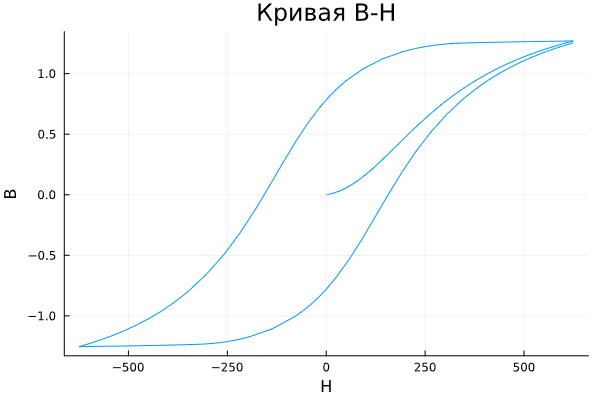Nonlinear Reluctance
Nonlinear magnetic resistance with hysteresis.
blockType: AcausalElectricPowerSystems.Passive.NonlinearReluctance
|
Path in the library: |
Description
The Nonlinear Reluctance block models nonlinear magnetic resistance with hysteresis. This block is used to create inductors and transformers with magnetic hysteresis.
Equations for linear parameterization of the magnetic resistance
The equations for linear parameterization of magnetic resistance are of the form:
,
Where:
-
- magnetic induction.
-
- magnetic constant.
-
- relative magnetic permeability.
-
- field strength.
-
- magnetomotive force (MDF) in the component.
-
- effective length of the modelled section.
-
- magnetic flux.
-
- effective cross-sectional area of the modelled section.
Equations for parameterization of magnetic resistance with one saturation point
This parameterization models a linear resistivity with two states. In the unsaturated state, the material has a given relative magnetic permeability. In the saturated state, the relative permeability is .
The equations for magnetic resistance with one saturation point are as follows
If
Otherwise,
Where:
-
- magnetic induction at saturation.
-
- magnetic resistance at saturation.
-
- relative magnetic permeability without saturation.
Parametrization of magnetic resistance by B-H curve
For the parameterization of the magnetic resistance, the material property of the B-H curve must be specified.
Equations for the parameterization of magnetic resistance with hysteresis
The equations for magnetic induction and magnetomotive force are of the form:
The block then realises the relationship between and according to the Jiles-Atterton equations. The equation linking and to the core magnetisation is as follows:
where:
-
- is the magnetisation of the core.
Magnetisation leads to an increase in induction and its magnitude depends on both the current value and the history of the field strength . The Jiles-Atterton equations are used in the block to determine at any point in time.
The figure below shows a typical plot of the resulting relationship between and .
In this case, at the initial instant of time, the magnetisation is zero, so the graph starts at . As the field strength increases, the graph tends towards an increasing hysteresis curve and as the rate of change of changes, the graph tends towards a decreasing curve. The difference between the increasing and decreasing curves is due to the dependence of on the trajectory history. Physically, this behaviour corresponds to the fact that the magnetic dipoles in the core align when the field strength increases, but do not fully return to their original position when the field strength decreases.

The starting point for the Jiles-Atterton equation is to divide the magnetisation effect into two parts, one of which is a function of the effective field strength ( ) and the other an irreversible history-dependent part:
The variable is called hysteresis-free magnetisation because it has no hysteresis. It is described by the following function on the current value of the effective field strength :
This function defines a saturation curve with limit values and a saturation point determined by the value of , the shape factor of the hysteresis-free curve. Roughly, it can be considered to describe the average of two hysteresis curves. In the block interface, the values are set at and points on the hysteresis-free curve B-H, which are used to determine the values of and .
The parameter is the magnetisation reversibility factor and determines which part of the behaviour is determined by , and which part is determined by the irreversible term . In the Jiles-Atterton model, the irreversible term is determined by the partial derivative of the field strength:
For , .
For , .
A comparison of this equation with the standard first order differential equation shows that as the field strength increases, the irreversible term tries to track the reversible term , but with a variable gain . The gain factor results in hysteresis at points where changes sign. The main parameter that forms the irreversible characteristic is , which is called the bulk coupling coefficient. The parameter is called the interdomain coupling coefficient and is also used to determine the effective field strength used to construct the hysteresis-free curve:
The value of affects the shape of the hysteresis loop: the intersection with the B-axis shifts upwards as the value increases. However, it should be noted that for stability, the term , which must be positive at and negative at , must be used. Therefore, not all values of are acceptable; a typical maximum value is of the order of 1e-3.
Procedure for finding approximate values of the coefficients of the Jiles-Atterton equation
The following procedure can be used to determine approximate values for the coefficients of the equation:
-
Specify the value of the Anhysteretic B-H gradient when H is zero ( at ) and the point on the hysteresis-free B-H curve. From these values, the values and are determined during block initialisation.
-
Set the value for Coefficient for reversible magnetisation, , so that the correct initial value of the B-H derivative is obtained when the simulation is started from the point . The value of is approximately equal to the ratio of this initial value of the derivative to the Anhysteretic B-H gradient when H is zero. The value of must be greater than
0and less than1. -
Set the value for Bulk coupling coefficient, K, to be approximately equal to the value of , when is on an increasing hysteresis curve.
-
Start with a very small value of and gradually increase it to adjust the value of when crossing the line . Typical values are in the range of
1e-4to1e-3. Values that are too large cause the derivative of the B-H curve to tend to infinity, which is contrary to physics and results in a programme execution error.
To get a good match with a given B-H curve, it may be necessary to perform these steps several times.
Parameters
Effective length - effective length of the modelled section
0.032 m (by default)
The effective length of the core, i.e. the average length of the magnetic core.
The value must be positive and not infinite.
Effective cross-sectional area - effective cross-sectional area
1.6e+5 m² (by default).
The effective cross-sectional area of the core, i.e. the average area of the magnetic flux path.
The value must be positive and not infinite.
Averaging period for power logging - excitation period used for averaging
0 s (By default)
Averaging period for calculating hysteresis losses. These losses are proportional to the area enclosed in the B-H trajectory. If the block is excited at a known, fixed frequency, this can be set equal to the corresponding excitation period to calculate the hysteresis losses. In this case, the block records the hysteresis losses once per AC cycle in the power_dissipated variable. If a fixed step solver is used, this value must be an integer multiple of the modelling step size.
If the block is not excited at a known, fixed frequency, set this parameter to 0. In this case, the block will set the power_dissipated value to zero, and you can calculate the actual hysteresis losses by post-processing the registered power_instantaneous variable.
Dependencies
This parameter is used if Nonlinear reluctance with hysteresis (JA model) is selected for Parameterised by.
Parameterised by is the method of parameterization of the B-H curve
Reluctance (B-H curve) (By default) | Linear reluctance | Reluctance with single saturation point | Nonlinear reluctance with hysteresis (JA model)
B-H curve parameterization method.
Relative magnetic permeability - relative magnetic permeability
5000 (By default)
Relative magnetic permeability.
The value must be positive and not infinite.
Dependencies
This parameter is used if Linear reluctance is selected for the Parameterised by parameter.
Unsaturated relative magnetic permeability - relative magnetic permeability
5000 (By default).
Relative magnetic permeability for an unsaturated inductor.
Dependencies
This parameter is used when `Reluctance with single saturation point' is selected for Parameterised by.
Magnetic flux density at saturation - magnetic induction
1.5 Tesla (by default).
Magnetic induction for saturated inductor.
The value must be positive and not infinite.
Dependencies
This parameter is used when `Reluctance with single saturation point' is selected for Parameterised by.
Magnetic field strength vector, H - vector of magnetic field strength values
[0, 200, 400, 600, 800, 1000] A/m (by default)
Magnetic field strength, , is specified as a vector with the same number of elements as in the vector of magnetic induction values, . The vector must start from zero and increase monotonically.
Dependencies
This parameter is used if Reluctance (B-H curve) is selected for Parameterised by.
Magnetic flux density vector - vector of magnetic induction values
[0, 1.25, 1.35, 1.44, 1.48, 1.49] TL (by default).
Magnetic induction, , is specified as a vector with the same number of elements as the magnetic field strength vector, . The vector must start from zero and increase monotonically.
Dependencies
This parameter is used if Reluctance (B-H curve) is selected for Parameterised by.
Anhysteretic B-H gradient when H is zero - derivative of hysteresis-free B-H curve near zero field strength
0.005 m*Tl/A (by default).
The gradient of the hysteresis-free B-H curve near zero field strength. Set as the average of the gradient of the increasing and decreasing hysteresis curves.
Dependencies
This parameter is used when Nonlinear reluctance with hysteresis (JA model) is selected for Parameterised by.
Flux density point on anhysteretic B-H curve - value of magnetic induction at a point on a hysteresis-free B-H curve
1.49 Tesla (by default).
Specify the value of magnetic induction at the point on the hysteresis-free curve. The most accurate option is to select the point at high field strength when the increasing and decreasing hysteresis curves coincide.
Dependencies
This parameter is used when Nonlinear reluctance with hysteresis (JA model) is selected for Parameterised by.
Corresponding field strength - Corresponding field strength
1000 A/m (By default).
Corresponding field strength for the point specified by Flux density point on anhysteretic B-H curve.
Dependencies
This parameter is used when Nonlinear reluctance with hysteresis (JA model) is selected for Parameterised by.
Coefficient for reversible magnetisation, c - coefficient of reversible magnetization
0.1 (by default).
The fraction of magnetisation that is reversible. The value must be greater than zero and less than one.
Dependencies
This parameter is used when Nonlinear reluctance with hysteresis (JA model) is selected for Parameterised by.
Bulk coupling coefficient, K - bulk coupling coefficient
200 A/m (By default).
A parameter of the Jiles-Atterton model that determines the value of field strength at which the B-H curve crosses the line of zero magnetic induction.
Dependencies
This parameter is used when Nonlinear reluctance with hysteresis (JA model) is selected for Parameterised by.
Inter-domain coupling factor, α - inter-domain coupling factor
0.0001 (By default).
Jiles-Atterton parameter affecting the points of intersection of the B-H curves with the zero field strength line. Typical values range from 1e-4 to 1e-3.
Dependencies
This parameter is used if Nonlinear reluctance with hysteresis (JA model) is selected for Parameterised by.
Interpolation option - interpolation method
Linear (By default) | Smooth.
The interpolation method that the block uses to determine values at intermediate time points not specified in the preceding vectors:
-
Linear- prioritises computational performance by using a linear function. -
Smooth- prioritises accuracy by obtaining a continuous curve with continuous first order derivatives.
